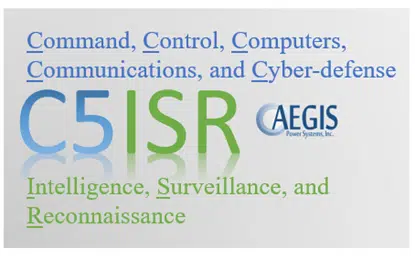C5ISR Definition and History
C5ISR is a term initiated by the US Army and used across many military applications related to command and control. Command and control is about directing the activities of many entities, people, organizations, information, and equipment towards accomplishing a common objective.
C5ISR is a two-part acronym; the first part is C5, while the second part is ISR. C5 is an acronym for Command, Control, Computers, Communications, and Cyber-defense. For the second part, ISR stands for Intelligence, Surveillance, and Reconnaissance. C5ISR supersedes C4ISR, which did not yet include the term “cyber-defense.” Further, C4ISR is a development of what was originally called C2, which consists only of command and control.
C5ISR and Modular Modern Military Equipment
Modern military equipment has become reliant on information technology for mission development and coordination. Conventional mission operations today include a high degree of interaction between virtual and real assets. These cyber-physical dynamics are anticipated to be incorporated into future battlespaces via both operating environment characteristics and the tools and methods needed to conduct C5ISR operations.
To guarantee reliable functioning and interoperability of modern military equipment, strong hardware regulatory standards are required. For example, these standards enable size, weight, and power (SWaP) reductions in C5ISR power supply systems and ensure platform compatibility by sharing hardware and software components. They allow for the inclusion of new standards on top of existing ones, which is what the different military-related consortiums are doing to enhance interoperability and minimize development and deployment time and cost. Additionally, sophisticated solutions may be supplied more rapidly with the use of cutting-edge technology. C5ISR/EW Modular Open Suite of Standards (CMOSS), Future Airborne Capability Environment (FACE), Hardware Open Systems Technologies (HOST), and Sensor Open System Architecture (SOSATM) are a few of these higher-level standards supporting the Modular Open Systems Approach (MOSA). Military open standards initiatives require interopable electronics such as VPX power supplies, some of which may be SOSA-aligned.
C5ISR Applications
C5ISR operations include a variety of applications and the specific equipment required to support them. Defense Communications, Deepwater Reconnaissance, Navigation and Timing, Aircraft Time and Frequency Reference, Tactical Radio, Signal Intelligence, GNSS Signal, and Data Center Operations are just a few of these uses. All of these operations need a certain quantity and quality of electricity and subsequent power converters and supplies.
C5ISR Power Supplies
The military depends on electricity for all elements of their missions, including technologies that allow situational awareness, connection, mission command, and actionable information. Thus enhanced capacities, such as communications systems, come with a power and energy cost. Strategic power and energy approaches, techniques, and solutions are required to lessen the burden, supply power, and minimize the logistical burden, which is a target of opportunity for enemies. Advanced, smaller, lighter weight, high efficiency power supplies, power generating systems, renewable energy sources, integrated environmental systems, and smart power grid technologies and systems are all part of tactical and deployed power efforts.
By changing the emphasis from energy consumption to power management, enabling energy informed operations is a military effort aimed at guaranteeing access and sustainment of power and energy as an integral component in the C5ISR operations.
Custom C5ISR Power Supplies
To be installed and operated successfully in these demanding mission-critical land, sea, and air platforms, custom power converters for military & avionics C5ISR operations must meet a wide variety of demanding technical and logistical criteria. Military power supplies often go through rigorous environmental testing, safety approvals, design verification testing (DVT), and HALT testing to ensure that they satisfy stringent standards. MIL-STD and DEF-STAN compliant AC-DC and DC-DC power converters are must different than commercial counterparts. Conducted immunity and conducted emissions requirements are two crucial aspects of power supply design. Immunity standards like Mil-Std 1275, Mil-Std 704, and Defense Standard 61-5 are widely utilized. Military vehicle requirements are covered by Mil-Std 1275, military aircraft PSU needs are covered by Mil-Std 704, and military vehicles, naval vessels, and aircraft are covered by Defense Standard 61-5.
Custom military power supply manufacturers must demonstrate conformity with national and military standards in order to participate in C5ISR activities. They must ensure reliability through effective component de-rating, design verification testing (DVT), avoiding planned obsolescence, long product life cycle and end of life (EOL) management, wide input voltage range for standard dc battery inputs, EMC/EMI control and protection against spikes and surges, rugged build standard, wide operating temperature range (typical -55°c to +125°c), convection or conduction-cooling, conducted immunity and conducted emissions , parallel and redundant functionality, and many other such requirements. Internal PSU protections against overheating, overvoltage, and overcurrent are also key.
Aegis Power Systems, Inc. welcomes the challenge to design and manufacture demanding rugged power supplies for your next military application. Get in touch with your requirements to see how we can support your project.

